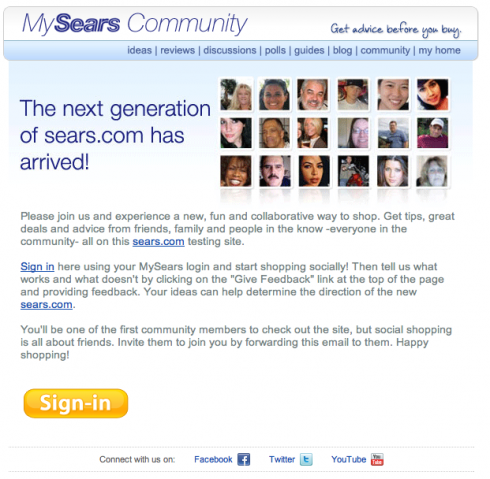
When I got the above email from Sears inviting me into a new social shopping experience, I hoped that they’d found a way to combine MySears and Sears.com together more contextually and pervasively, letting me move easily between the “get advice before you buy” approach of MySears.com (with its action verbs being join, explore, and connect) and the shopping focused Sears.com.
They haven’t, but what they have done is introduce more social functionality into the shop. Visit sears.com and in the utility navigation right underneath the multi-brand bar (Sears, Kmart, Crafstman, Kenmore, Lands End, etc) you should see an option which toggles between “visit our social site” and “leave our social site.” Clicking on “visit our social site” and you’re greated with this splash screen explaining the new experience:
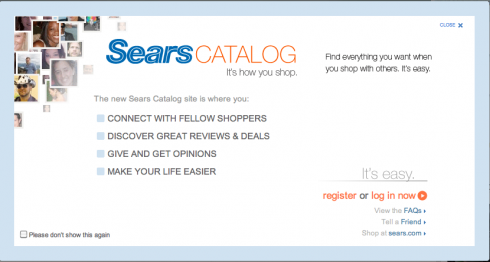
It seems Sears has added a bit of social networking functionality as an overlay to the shopping experience, letting you “message” and “follow” other users, seeing their (on site) social activity. You can view profiles, see who other users are following and followed by, get badges, join groups, and do many of the other activities we’ve come to expect in the era of Facebook and Twitter.
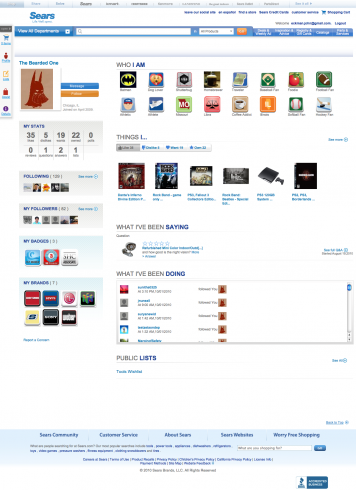
What’s more unusual is the relationship this new social site has to the existing store and community. MySears.com continues to exist on it’s own tab, suggesting a separation between the researching activities (“get advice before you buy”) and the shopping activity of Sears.com. But the new social site is essentially a kind of layer over the regular shop.
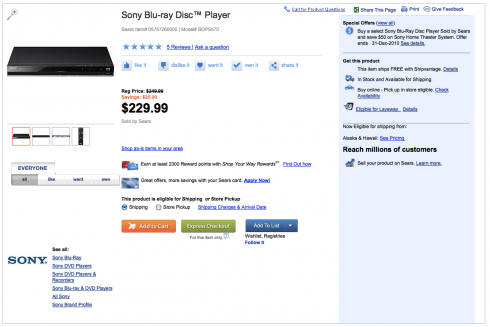
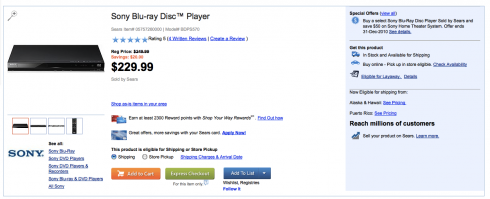
Look at these two cropped product detail pages. Both are of the same product in the Sears.com product catalog – a Blu-Ray DVD player. One image is from within the social site (note the toggle says “leave our social site”) and the other is from outside the social site (“visit our social site” being the link). The language suggests that the social site is a separate place (one you visit and leave) but the experience suggests that social is more like a layer you turn on and off – like the virtual reality overlay in an iphone application which adds review information to your camera view of the street on which you’re walking.
| The “non-social” view is: | The “social” view is: |
| – Product summary, including ratings and photos, and links to other Sony products | – Product summary, with options to like it, dislike it, own it, want it, and share it, as well as activity from your network (all, like, want, or own) for this item |
| – Product description | – Product description |
| – Wiki Product description | |
| – Frequently bought together | – Frequently brought together |
| – People who viewed this item also viewed | – People who viewed this item also viewed |
| – Specifications | – Q & A |
| – Community Discussions | – Community Discussions |
| – Sears Can Help | – Sears Can Help |
| – Social (repeat of the activity for this item: all/like/want/own) | |
| – Customer Ratings and Reviews | – Customer Ratings and Reviews |
| – People who bought this item also bought | – People who bought this item also bought |
In other words, there’s only a few rows of difference, mixing some social activity (Q&A) in place of specifications, adding a product wiki, and repeating the social network information (people in your network who like/want/own the item being viewed) again later in the page.
Unfortunately there’s a lot of empty social areas at this point – not many items that lots of people in the network have liked/disliked/wanted/owned. It also seems like asking a lot to require users to now find new folks to follow, rather than importing and matching their social graph from Facebook, Twitter, or an email address book search. You can invite people via email, but I didn’t see any easy way to build a new network.
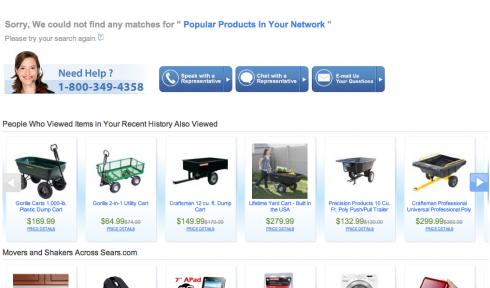
What do you think of what Sears is trying here?
I love the idea of activity streams (and the standard for syndication of them) in the context of shopping (see Swipely, Blippy, and Shwowp), but I’m not sure how Sears will get enough critical mass built up if users have to specifically choose to follow each other, and their activity is only visible inside Sears’ own walled garden.
Like Automattic, they’ve essentially avoided the Facebook “like” button in favor of their own – but will users go to the trouble of liking a product in multiple places, or will Sears just end up with a quiet network where the only active users are associates?

Also from Sears:
http://bit.ly/aAJLb2
Thanks for the profile and analysis on Sears Catalog. It’s a work in progress. We are always testing, tweaking and measuring everything to make each iteration better than the last.
Be sure to also check out Delver, our other innovative social shopping initiative: http://bit.ly/bOnFPO. Let us know what you think!
Philip Nowak